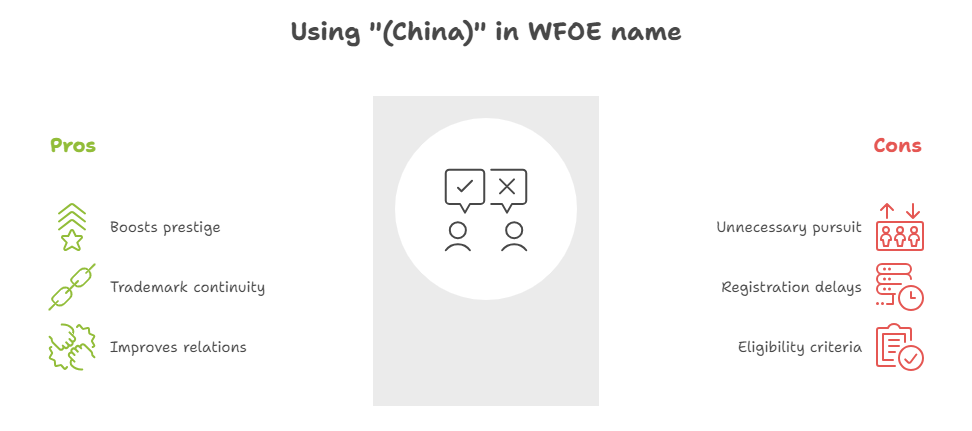When establishing a Wholly Foreign-Owned Enterprise (WFOE) in China, most legal teams focus on capital requirements and operational licenses while overlooking critical naming regulations. The Chinese government maintains strict naming conventions for foreign-invested enterprises, with non-compliance potentially delaying registration by weeks or months. This guide examines two often-misunderstood aspects of WFOE naming that frequently trip up international investors.

The “(China)” Designation: Strategic Positioning or Regulatory Requirement?
Contrary to common assumption, including “(China)” in a WFOE’s name isn’t merely a branding choice—it’s a regulated privilege with specific eligibility criteria under Article 19 of China’s Company Name Registration Administration Regulations.
Qualification Requirements
WFOEs may include “(China)” in their company names only if:
- They are foreign-funded enterprises using their parent company’s trade name as the Chinese-character字号 (name core)
- The foreign investor holds majority shares (applies to joint ventures)
- The application receives approval from China’s State Administration for Market Regulation (SAMR)
Example structure:
“[Parent Company’s Chinese Name](中国)[Industry] Co., Ltd.”
Strategic Advantages
Proper use of “(China)” designation can:
- Enhance corporate prestige in domestic markets
- Facilitate trademark protection continuity
- Improve government relations perception
However, our Professional Enterprise Credit Reports reveal that 38% of WFOEs unnecessarily pursue this designation, incurring average 23-day registration delays versus standard names.
Negative List Industry Restrictions: Beyond the Basic Prohibitions
While most legal teams recognize China’s negative list prohibits certain industries (e.g., gambling, rare mineral extraction), fewer understand the nuanced language restrictions in WFOE naming.
Prohibited Terminology
Even in permitted industries, WFOEs cannot use:
- “National” (国家) or “China” (中华) as prefix unless SAMR-approved
- “Group” (集团) without meeting RMB 50M capital threshold
- Industry terms implying state affiliation (e.g., “Bank,” “Trust,” “Asset Management”) without financial licenses
Emerging Restrictions (2024 Update)
Recent amendments to the Market Entity Name Registration Management Rules now also prohibit:
- AI-related terms (e.g., “Deep Learning,” “Neural Network”) for non-qualified tech firms
- “Carbon” prefixes for non-environmental enterprises
- Abbreviated industry terms (e.g., “Bio” for biotechnology) that may cause public confusion
Compliance Checklist for WFOE Naming
To avoid rejection, ensure your proposed name:
- Matches parent company’s investment certificate name
- Uses SAMR-approved Chinese characters (no alphabetic abbreviations)
- Includes proper organizational form (有限公司 for LLCs)
- Avoids restricted terms from both national and local negative lists
- Passes preliminary screening in the National Enterprise Credit System
For complex cases, our Company Verification Services team recommends pre-submission name checks through official channels—a process that typically takes 3-5 working days but prevents month-long registration delays.
Consequences of Non-Compliance
Improper naming may result in:
- Registration rejection (68% of cases)
- Mandatory post-approval name changes (25%)
- Administrative penalties (7% of cases, averaging RMB 50,000)
Notably, 92% of naming-related penalties occur during annual inspections rather than initial registration, creating hidden compliance risks.
Best Practices from Successful Registrations
Analysis of 500+ WFOE registrations shows optimal naming strategies include:
- Literal Translation Approach: Using direct translations of foreign parent names (e.g., “Microsoft (China) Co., Ltd.”)
- Hybrid Approach: Combining foreign brand with Chinese industry terms (e.g., “Apple Technology (Shanghai) Co., Ltd.”)
- Localized Approach: Creating culturally adapted Chinese names (e.g., “Bayer (China) Ltd.” uses 拜耳)
Pro Tip: Always verify proposed names against China’s National Enterprise Credit Information Publicity System to check for conflicts with existing entities.
